Abstract
The deoxyribonucleic acid (DNA) relationships of 80 strains identified either as Vibrio parahaemolyticus, V. alginolyticus, and V. anguillarum, or as allied marine vibrios were delineated by DNA-DNA competition experiments as well as by measuring the thermal stabilities of the DNA-DNA duplexes formed in direct binding studies. The tested strains included isolates from Japan, Europe, and the United States. The V. parahaemolyticus and V. alginolyticus groups showed an average of 67% homology to one another and 30% to strains of V. anguillarum. Significantly, a number of the isolates from the Pacific Northwest which had been previously identified as V. parahaemolyticus based on morphological, biochemical, and serological evidence were shown either to be strains of V. anguillarum or to belong to as yet unnamed groups. Most strains isolated from diseased salmon in the Pacific Northwest proved to be virtually identical with V. anguillarum type C by DNA homology experiments, thereby differentiating them from similar strains isolated from diseased herring and occasionally from salmon. The latter Pacific Northwest isolates fell into two distinct genotypic groups. A plot of the per cent homology by competition versus the difference in the thermal stabilities of heterologous and homologous duplexes (ΔTm,e) between the same DNA species shows a linear decline in homology of 4.25% per degree of ΔTm,e. The use of this relationship for estimating the percentage of the mispaired bases distinguishing DNA preparations directly from competition experiments is discussed.
Full text
PDF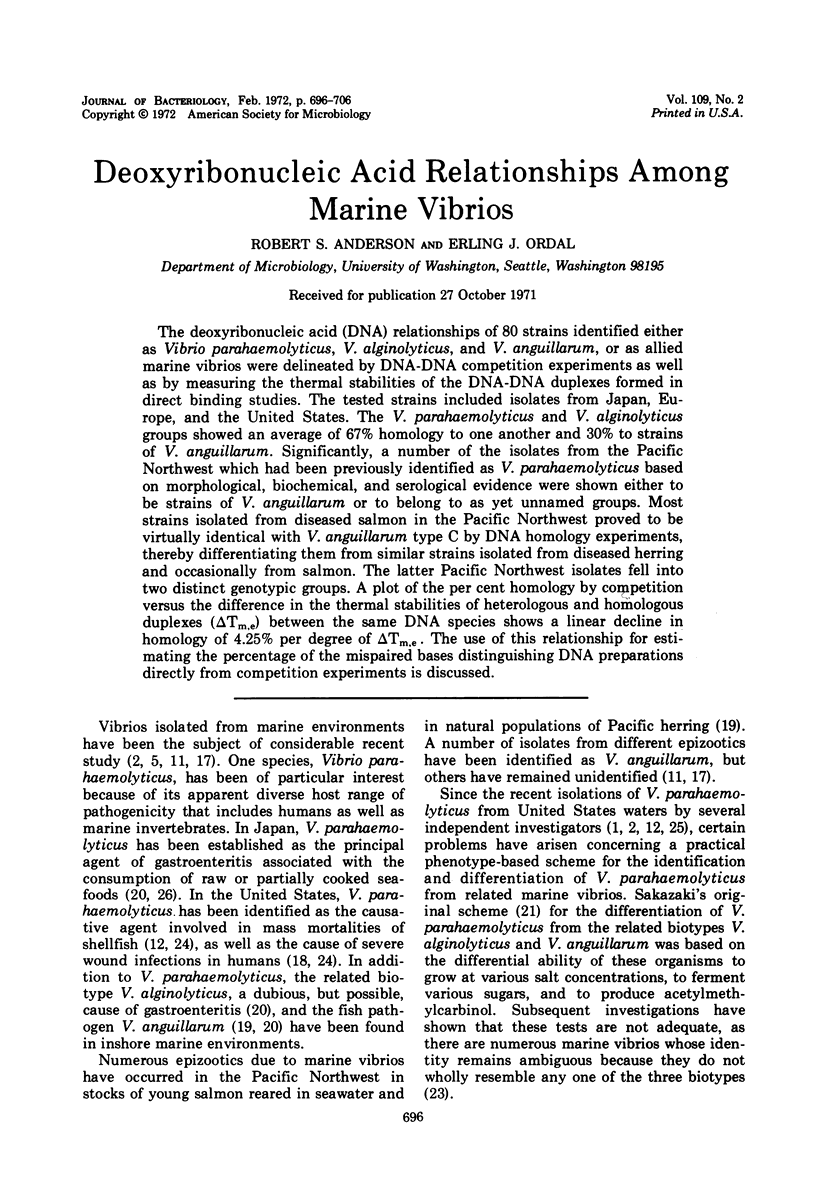
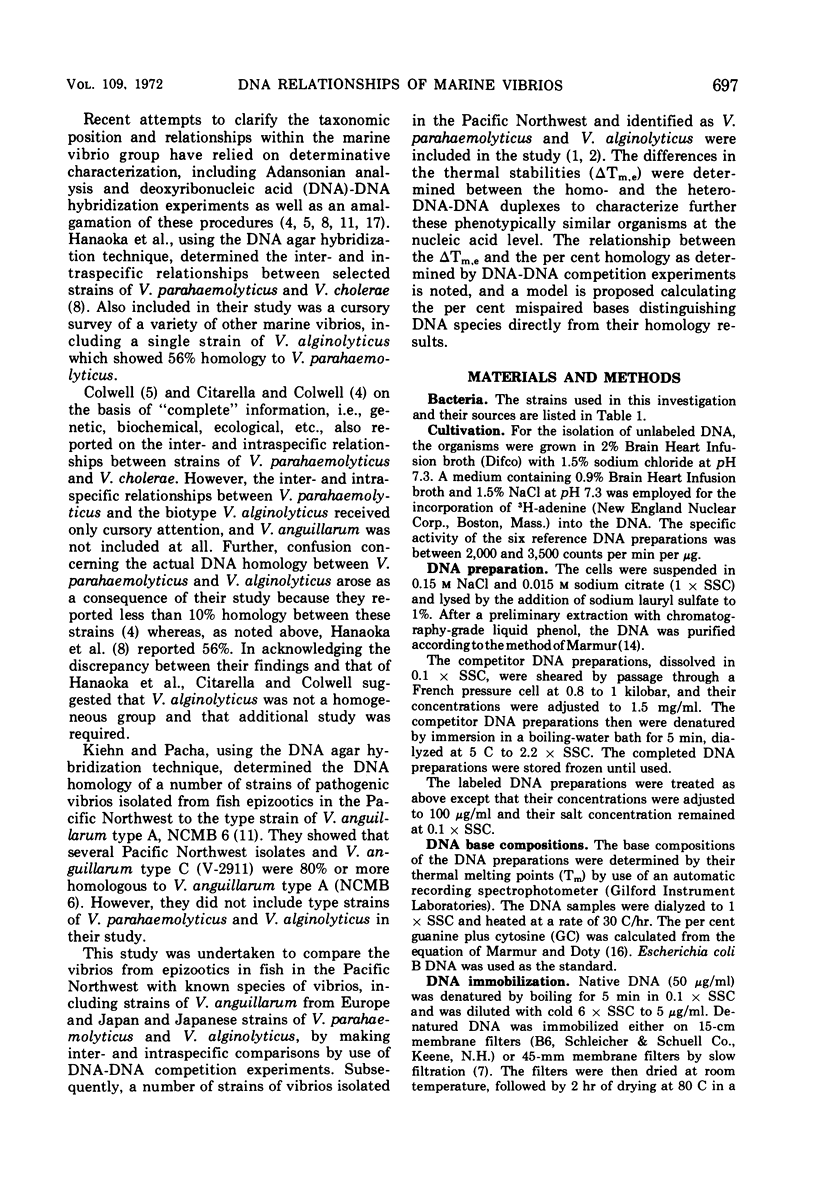
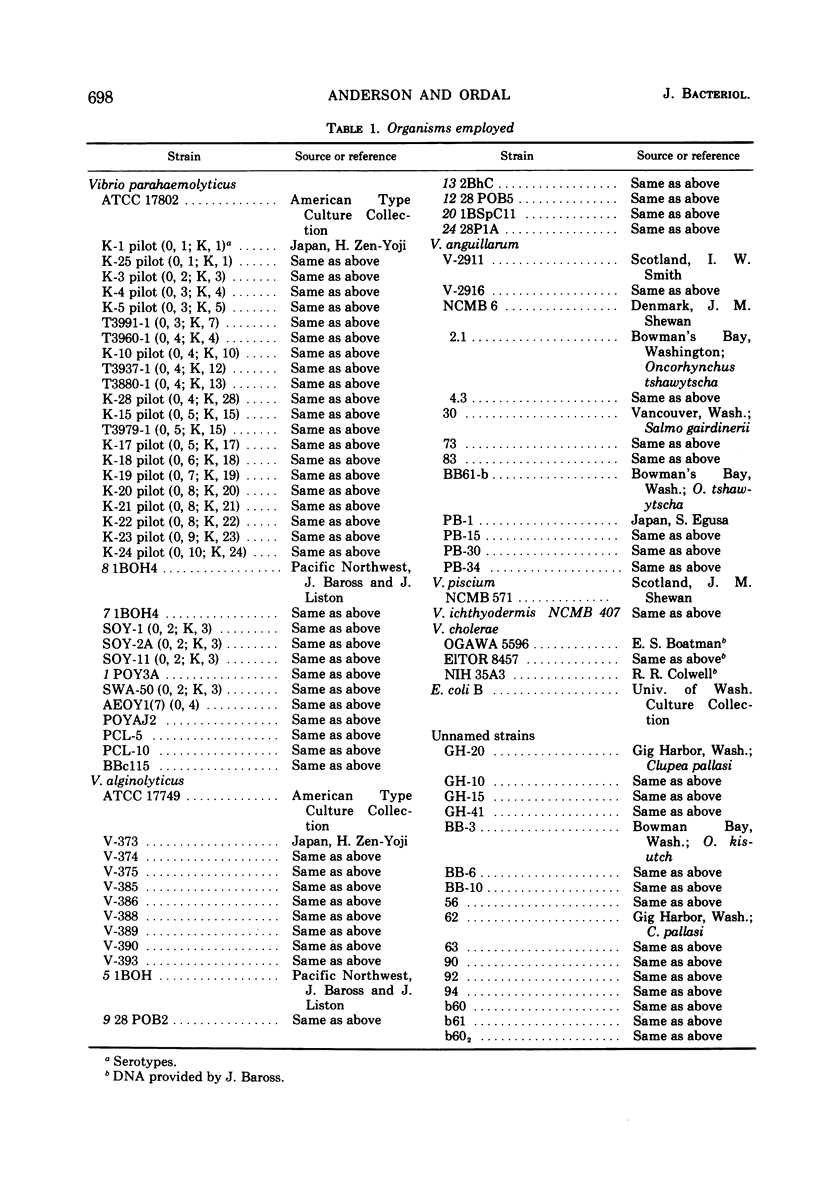
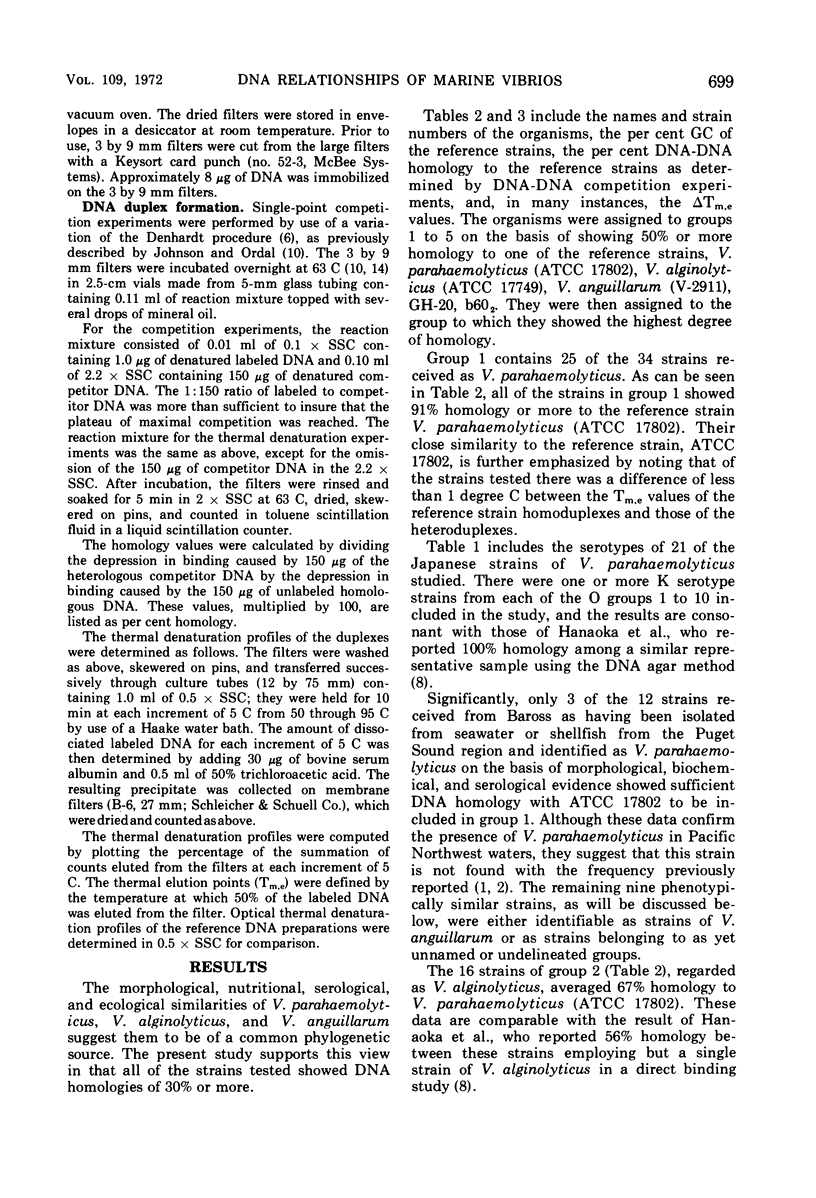
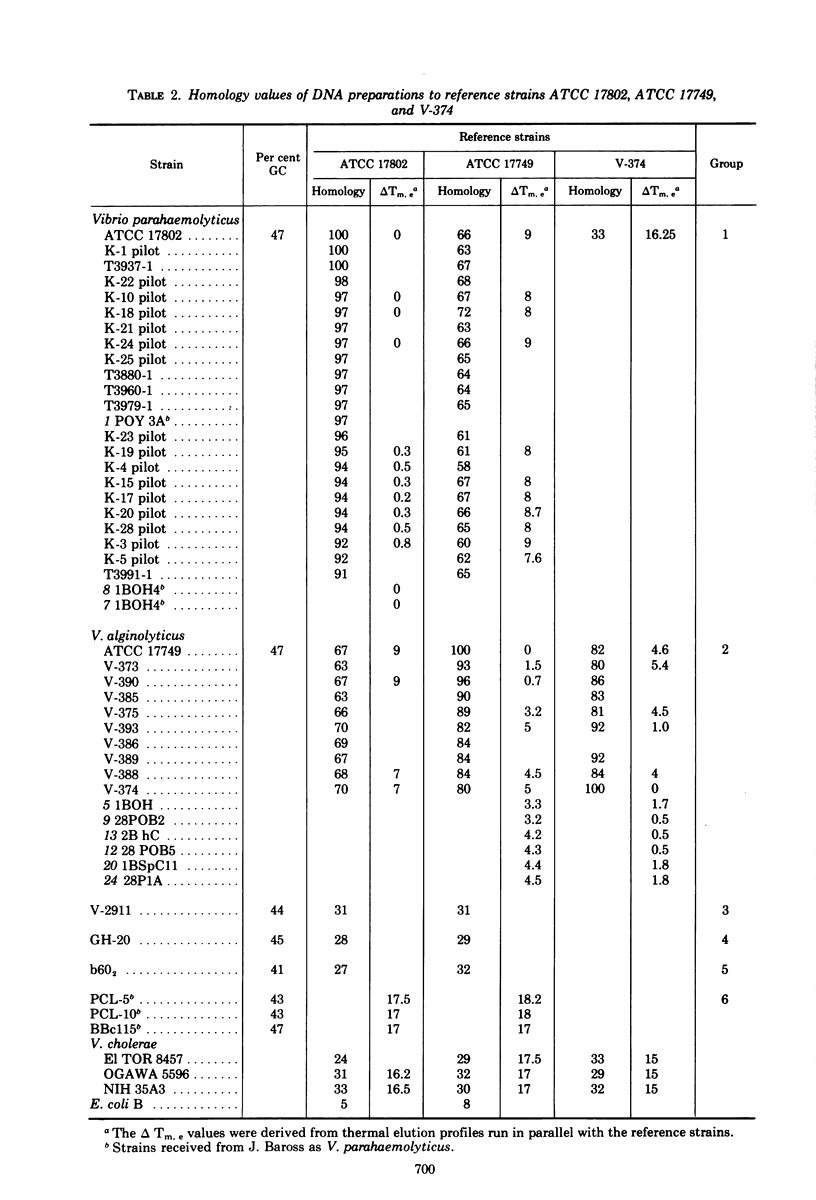
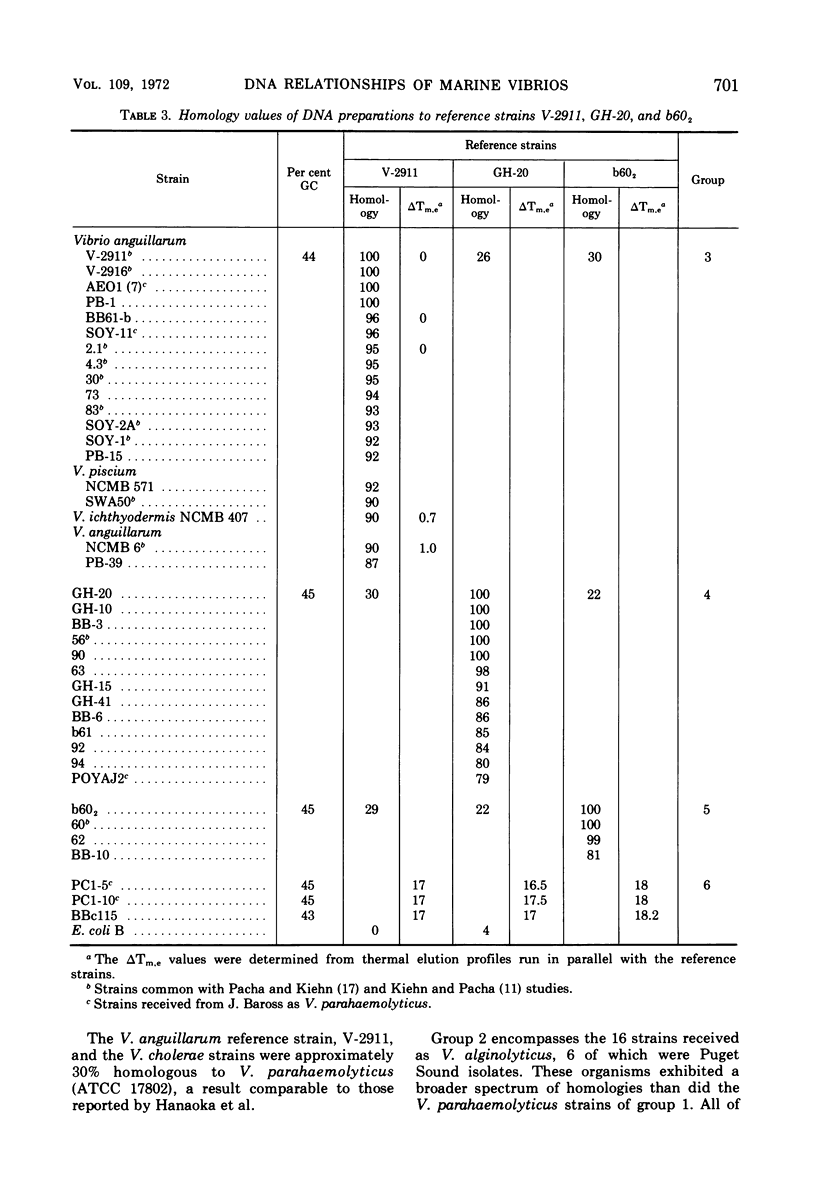
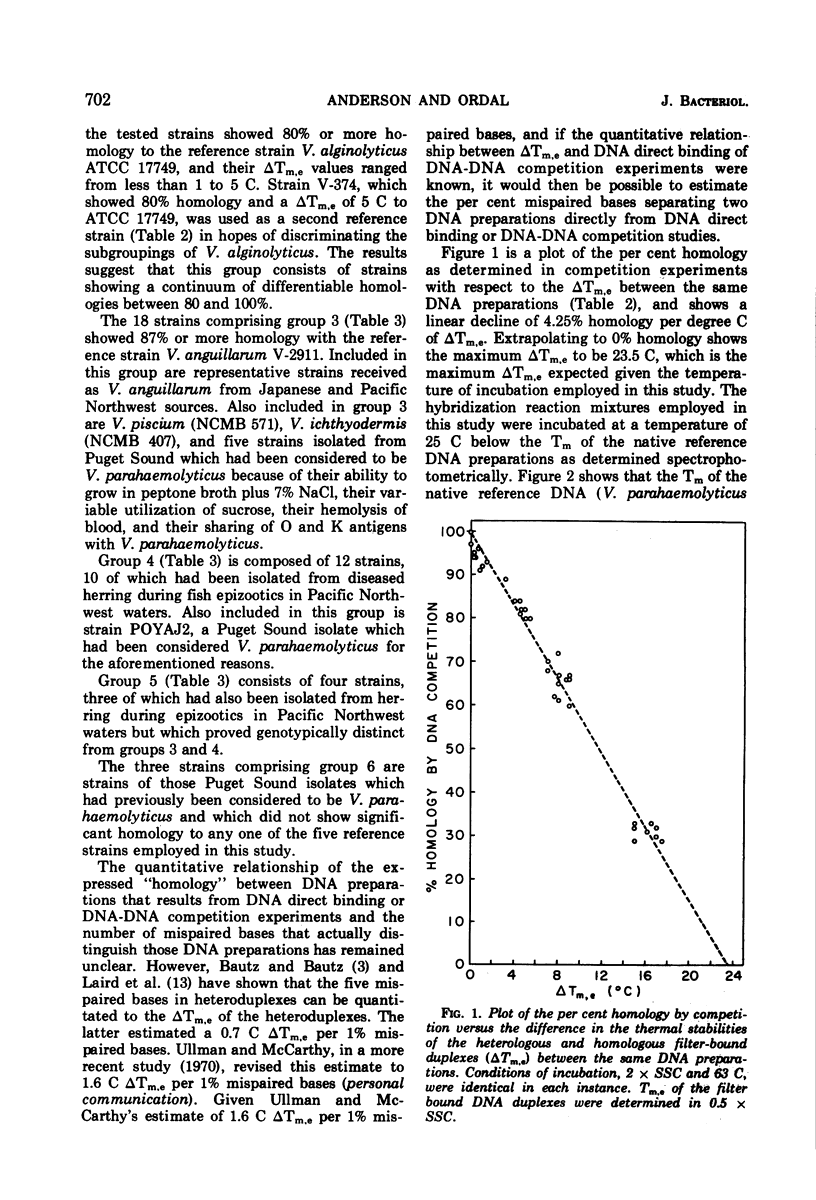
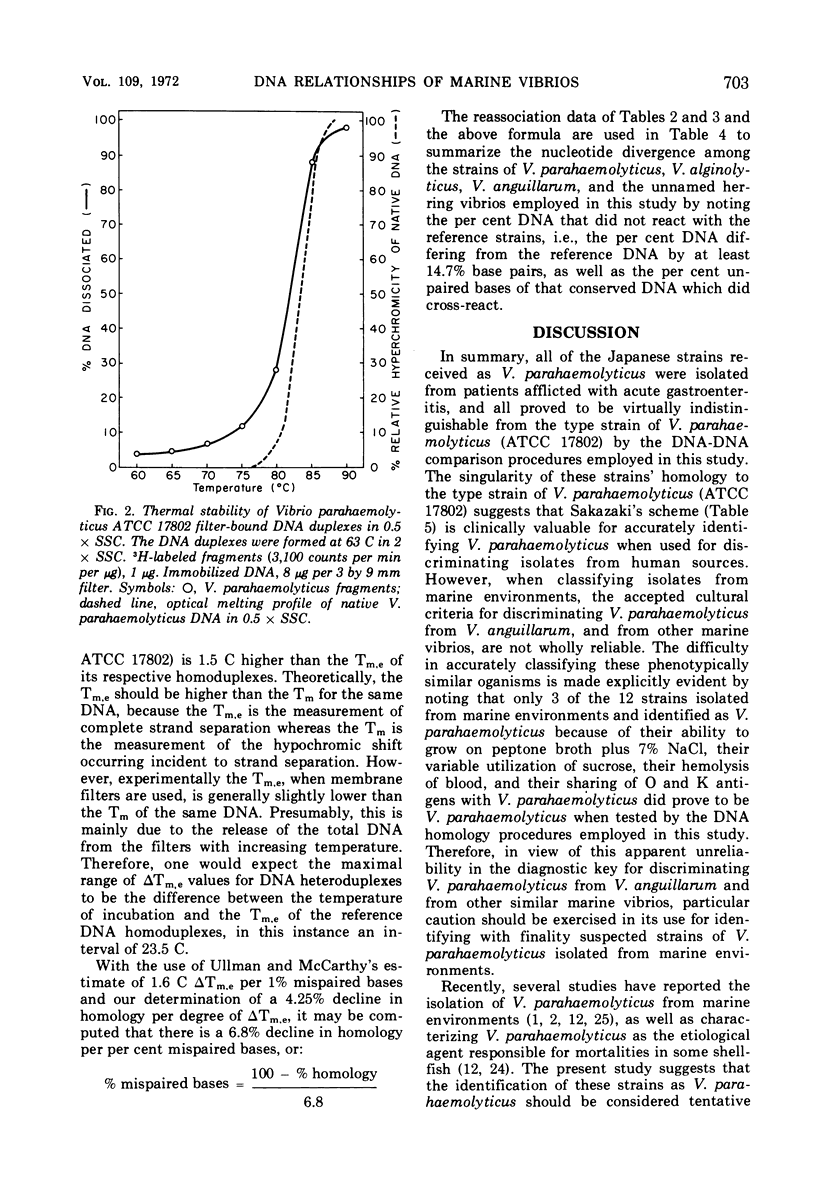
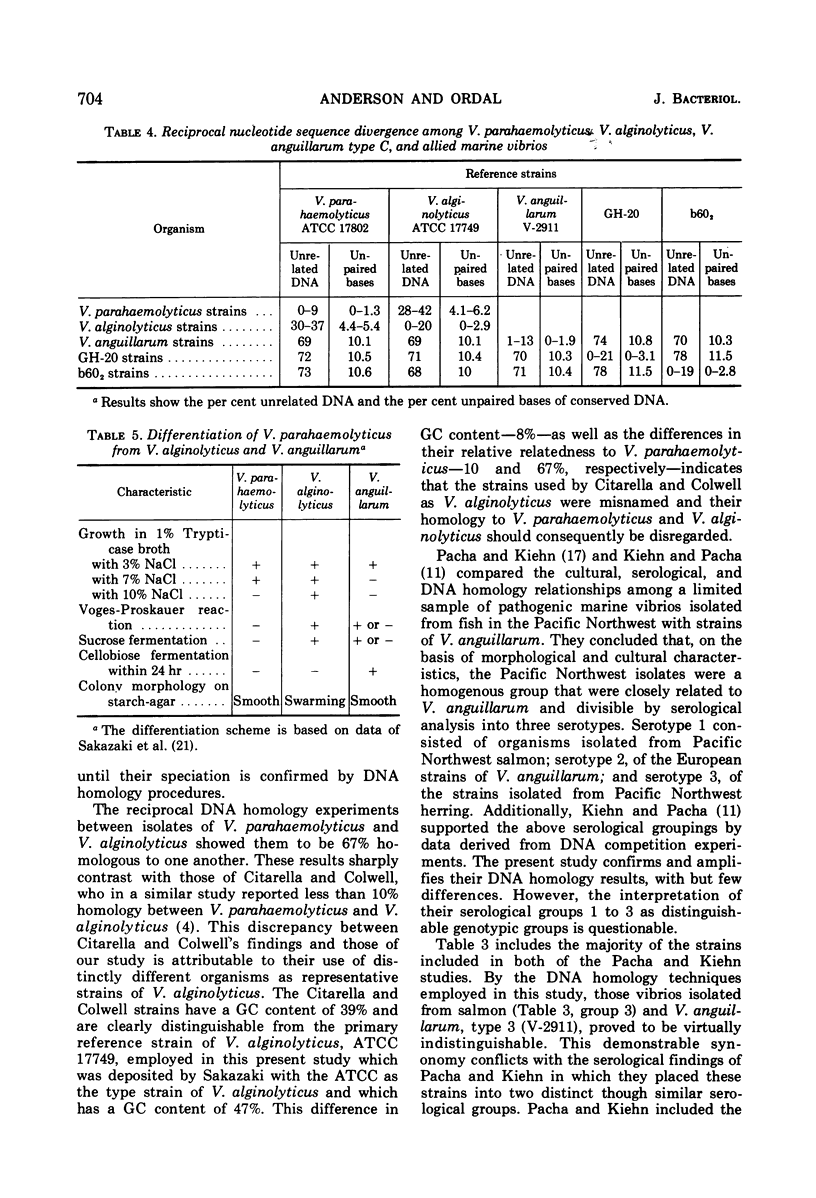
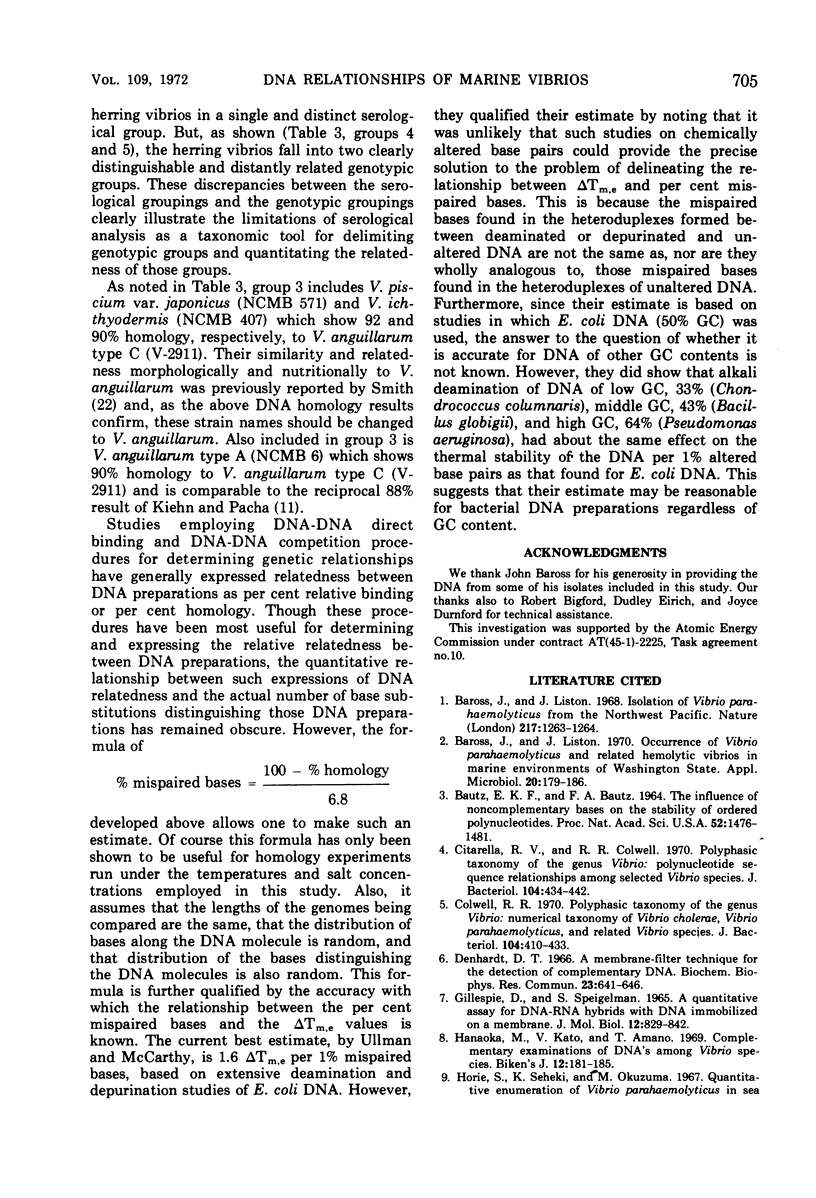
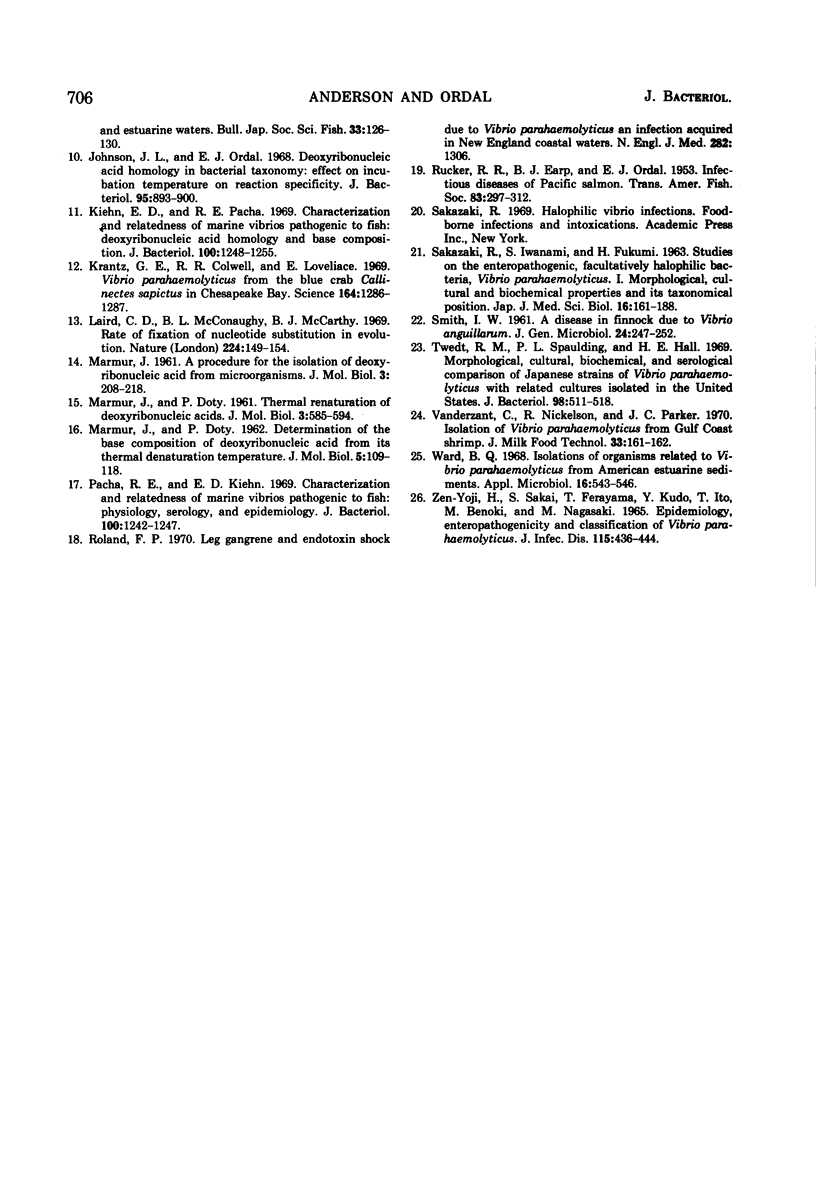
Selected References
These references are in PubMed. This may not be the complete list of references from this article.
- BAUTZ E. K., BAUTZ F. A. THE INFLUENCE OF NONCOMPLEMENTARY BASES ON THE STABILITY OF ORDERED POLYNUCLEOTIDES. Proc Natl Acad Sci U S A. 1964 Dec;52:1476–1481. doi: 10.1073/pnas.52.6.1476. [DOI] [PMC free article] [PubMed] [Google Scholar]
- Baross J., Liston J. Isolation of vibrio parahaemolyticus from the Northwest Pacific. Nature. 1968 Mar 30;217(5135):1263–1264. doi: 10.1038/2171263a0. [DOI] [PubMed] [Google Scholar]
- Baross J., Liston J. Occurrence of Vibrio parahaemolyticus and related hemolytic vibrios in marine environments of Washington State. Appl Microbiol. 1970 Aug;20(2):179–186. doi: 10.1128/am.20.2.179-186.1970. [DOI] [PMC free article] [PubMed] [Google Scholar]
- Citarella R. V., Colwell R. R. Polyphasic taxonomy of the genus Vibrio: polynucleotide sequence relationships among selected Vibrio species. J Bacteriol. 1970 Oct;104(1):434–442. doi: 10.1128/jb.104.1.434-442.1970. [DOI] [PMC free article] [PubMed] [Google Scholar]
- Colwell R. R. Polyphasic taxonomy of the genus vibrio: numerical taxonomy of Vibrio cholerae, Vibrio parahaemolyticus, and related Vibrio species. J Bacteriol. 1970 Oct;104(1):410–433. doi: 10.1128/jb.104.1.410-433.1970. [DOI] [PMC free article] [PubMed] [Google Scholar]
- Denhardt D. T. A membrane-filter technique for the detection of complementary DNA. Biochem Biophys Res Commun. 1966 Jun 13;23(5):641–646. doi: 10.1016/0006-291x(66)90447-5. [DOI] [PubMed] [Google Scholar]
- Gillespie D., Spiegelman S. A quantitative assay for DNA-RNA hybrids with DNA immobilized on a membrane. J Mol Biol. 1965 Jul;12(3):829–842. doi: 10.1016/s0022-2836(65)80331-x. [DOI] [PubMed] [Google Scholar]
- Hanaoka M., Kato Y., Amano T. Complementary examination of DNA'S among Vibrio species. Biken J. 1969 Sep;12(3):181–185. [PubMed] [Google Scholar]
- Johnson J. L., Ordal E. J. Deoxyribonucleic acid homology in bacterial taxonomy: effect of incubation temperature on reaction specificity. J Bacteriol. 1968 Mar;95(3):893–900. doi: 10.1128/jb.95.3.893-900.1968. [DOI] [PMC free article] [PubMed] [Google Scholar]
- Kiehn E. D., Pacha R. E. Characterization and relatedness of marine vibrios pathogenic to fish: deoxyribonucleic acid homology and base composition. J Bacteriol. 1969 Dec;100(3):1248–1255. doi: 10.1128/jb.100.3.1248-1255.1969. [DOI] [PMC free article] [PubMed] [Google Scholar]
- Krantz G. E., Colwell R. R., Lovelace E. Vibrio parahaemolyticus from the blue crab Callinectes sapidus in Chesapeake Bay. Science. 1969 Jun 13;164(3885):1286–1287. doi: 10.1126/science.164.3885.1286. [DOI] [PubMed] [Google Scholar]
- Laird C. D., McConaughy B. L., McCarthy B. J. Rate of fixation of nucleotide substitutions in evolution. Nature. 1969 Oct 11;224(5215):149–154. doi: 10.1038/224149a0. [DOI] [PubMed] [Google Scholar]
- MARMUR J., DOTY P. Determination of the base composition of deoxyribonucleic acid from its thermal denaturation temperature. J Mol Biol. 1962 Jul;5:109–118. doi: 10.1016/s0022-2836(62)80066-7. [DOI] [PubMed] [Google Scholar]
- MARMUR J., DOTY P. Thermal renaturation of deoxyribonucleic acids. J Mol Biol. 1961 Oct;3:585–594. doi: 10.1016/s0022-2836(61)80023-5. [DOI] [PubMed] [Google Scholar]
- Pacha R. E., Kiehn E. D. Characterization and relatedness of marine vibrios pathogenic to fish: physiology, serology, and epidemiology. J Bacteriol. 1969 Dec;100(3):1242–1247. doi: 10.1128/jb.100.3.1242-1247.1969. [DOI] [PMC free article] [PubMed] [Google Scholar]
- Roland F. P. Leg gangrene and endotoxin shock due to vibrio parahaemolyticus--an infection acquired in New England coastal waters. N Engl J Med. 1970 Jun 4;282(23):1306–1306. doi: 10.1056/NEJM197006042822306. [DOI] [PubMed] [Google Scholar]
- SAKAZAKI R., IWANAMI S., FUKUMI H. STUDIES ON THE ENTEROPATHOGENIC, FACULTATIVELY HALOPHILIC BACTERIA, VIBRIO PARAHAEMOLYTICUS. I. MORPHOLOGICAL, CULTURAL AND BIOCHEMICAL PROPERTIES AND ITS TAXONOMICAL POSITION. Jpn J Med Sci Biol. 1963 Aug;16:161–188. doi: 10.7883/yoken1952.16.161. [DOI] [PubMed] [Google Scholar]
- Twedt R. M., Spaulding P. L., Hall H. E. Morphological, cultural, biochemical, and serological comparison of Japanese strains of Vibrio parahemolyticus with related cultures isolated in the United States. J Bacteriol. 1969 May;98(2):511–518. doi: 10.1128/jb.98.2.511-518.1969. [DOI] [PMC free article] [PubMed] [Google Scholar]
- Ward B. Q. Isolations of organisms related to Vibrio parahemolyticus from American estuarine sediments. Appl Microbiol. 1968 Mar;16(3):543–546. doi: 10.1128/am.16.3.543-546.1968. [DOI] [PMC free article] [PubMed] [Google Scholar]
- Zen-Yoji H., Sakai S., Terayama T., Kudo Y., Ito T., Benoki M., Nagasaki M. Epidemiology, enteropathogenicity, and classification of Vi.rio parahaemolyticus. J Infect Dis. 1965 Dec;115(5):436–444. doi: 10.1093/infdis/115.5.436. [DOI] [PubMed] [Google Scholar]


